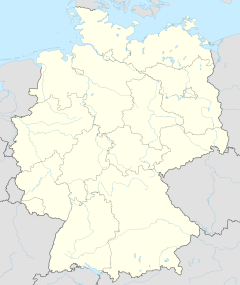Belvedere on the Pfingstberg
| Belvedere on the Pfingstberg | |
|---|---|
| Belvedere auf dem Pfingstberg | |

The Belvedere on the Pfingstberg
|
|
| General information | |
| Type | Palace, viewing structure |
| Architectural style | Renaissance |
| Town or city | Potsdam |
| Country | Germany |
| Groundbreaking | 1847 |
| Completed | 1863 |
| Renovated | 1988-2005 |
| Landlord | Stiftung Preussische Schlösser und Gärten |
| Design and construction | |
| Architect |
Ludwig Persius, Friedrich August Stüler, , Peter Joseph Lenné (gardens) |
| UNESCO World Heritage Site | |
|---|---|
| Location |
Germany |
| Criteria | i, ii, iv |
| Reference | 532 |
| Coordinates | 52°25′07″N 13°03′32″E / 52.4187°N 13.059°E |
| Inscription | (Unknown Session) |
|
[]
|
|
The Belvedere on the Pfingstberg (German: Belvedere auf dem Pfingstberg) is a palatial building in the northern part of the New Garden in Potsdam, Germany, atop Pfingstberg hill.
It was commissioned by King Friedrich Wilhelm IV of Prussia and is only one part of an originally substantially more extensive building project. The twin-towered building was modeled on Italian Renaissance architecture and was to serve as a viewing place for the visitors of the garden. It was built between 1847 and 1863 with an interruption from 1852 to 1860. From sketches from the king, the architects Ludwig Persius, Friedrich August Stüler and drew up detailed plans. The garden architect Peter Joseph Lenné was responsible for the design of the grounds.
The building fell into disrepair during World War II and in the period of the German Democratic Republic, but was repaired between 1988 and 2005 by a group of local residents. Today, the Belvedere is open to visitors.
Since 1999, the palace has been a part of the UNESCO World Heritage Site Palaces and Parks of Potsdam and Berlin.
Interior courtyard
Interior courtyard
Colonnade
Front yard seen from above
Coordinates: 52°25′08″N 13°03′32″E / 52.4188°N 13.0590°E
...
Wikipedia


